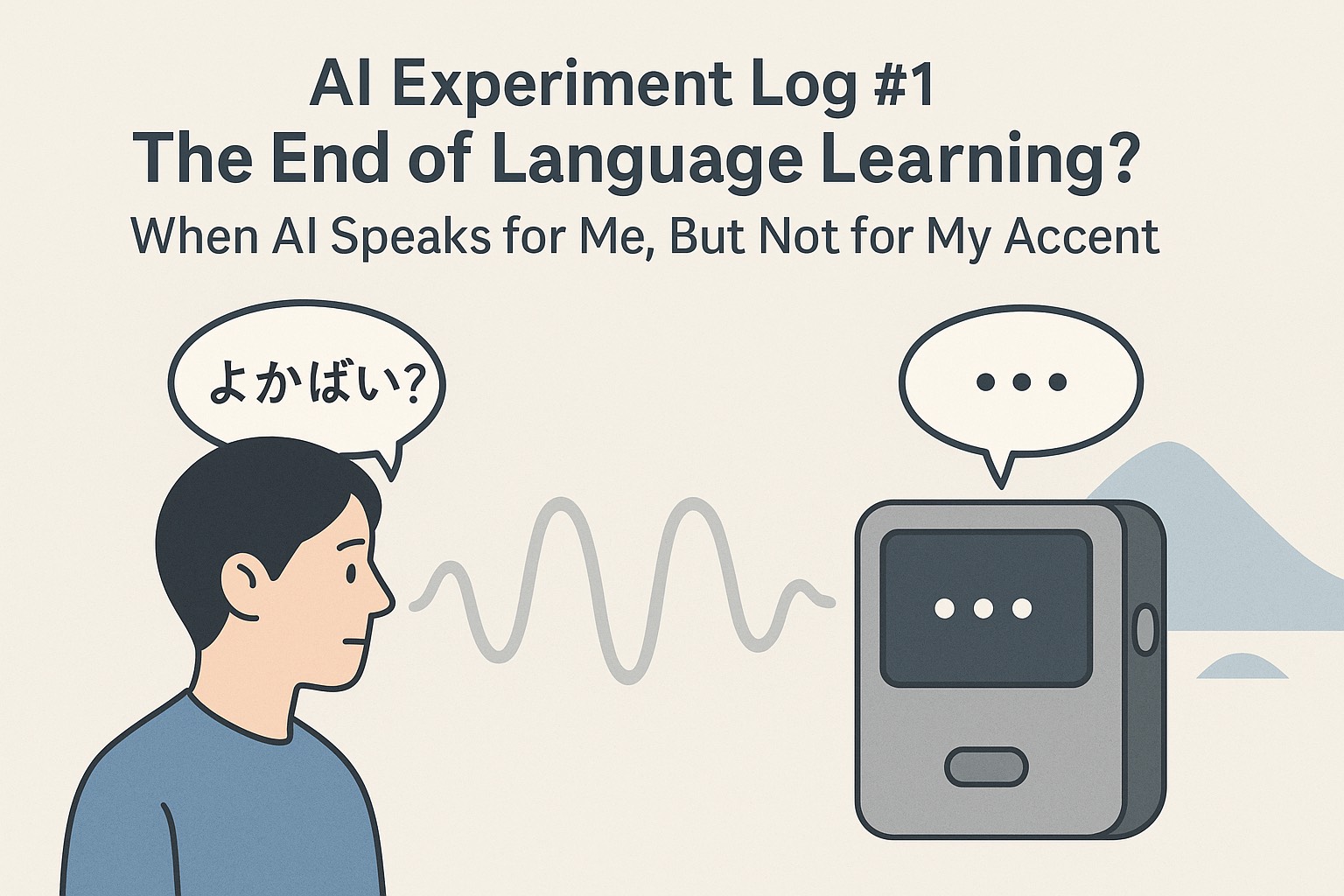When AI Speaks for Us, But Not for Our Accents
This experiment tested how accurately AI translation can handle regional Japanese accents compared to standard Japanese speech.
Introduction
This experiment examines the limits of AI-driven translation when dealing with regional Japanese accents.
The test was motivated by a simple yet revealing situation: I cannot speak, read, or write English, yet I communicate daily through an AI translation device called AI Card.
It instantly translates my words into English, making me feel as though traditional language learning might be obsolete.
However, when my acquaintance attempted to use their native Kumamoto dialect, the translation completely failed.
This unexpected result exposed a critical gap between linguistic understanding and cultural context in AI-driven communication systems.
Test Environment & Conditions
The experiment was conducted using AI Card, a mobile translation and interpretation application running on an iPhone (iOS environment).
Testing date: Late September 2025.
Network: Wi-Fi connection (stable).
Language pair: Japanese ⇄ English.
Speech input mode: Voice-to-Voice real-time translation.
Accent condition: Natural Kumamoto dialect (Southern Japanese regional accent).
No manual correction or secondary transcription was applied.
⚠️ The AI system occasionally auto-completed unclear phrases for consistency during translation output.
Procedure
- Activated AI Card’s voice translation mode.
- Spoke short, natural Japanese phrases in the Kumamoto dialect (e.g., greetings, casual remarks).
- Observed real-time English translation displayed and read aloud by AI Card.
- Compared expected meaning with actual output.
- Repeated the same phrases using standard Japanese pronunciation as a control test.
The test aimed to measure the semantic accuracy gap between dialectal and standardized inputs, highlighting AI’s sensitivity to phonetic variation.
Results
Accuracy Comparison (Qualitative)
| Input Type | Recognition Behavior | Meaning Preservation | Example Result |
|---|---|---|---|
| Standard Japanese | Recognized continuously with minimal interruption. | Meaning mostly preserved. | “Good morning, how are you?” → [OK] Correct |
| Kumamoto Dialect | Recognition frequently broke or merged sounds. | Output included katakana-like words instead of semantic translations. | “Yo kan nabe?” → [X] Unrelated English phrase |
Summary Table
| Category | Observation |
|---|---|
| Accent Handling | Misrecognition prominent when dialectal intonation present. |
| Semantic Retention | Regional expressions often failed to map to meaning. |
| Context Prediction | Model tended to replace unknown phrases with generic sentences. |
| Response Latency | Slightly slower than standard Japanese input. No quantitative measurement conducted. |
When tested with strong Kumamoto inflection, the AI output frequently included katakana-like transcriptions that combined multiple Japanese words into a single token.
For example, two consecutive words spoken naturally in dialect were merged into one “pseudo-word,” as if the AI attempted to treat the continuous sound as a single unit.
This suggests that the model could not detect clear word boundaries and instead normalized the entire segment into an acoustically similar pattern — a predictable artifact of phoneme-based recognition systems.
In contrast, standard Japanese pronunciation yielded consistent and accurate translations, reinforcing that AI’s comprehension still relies heavily on phonetic normalization rather than true semantic understanding.
In qualitative terms, recognition accuracy for dialectal input was roughly 60–70% compared to near 100% for standard Japanese.
Analysis
The AI translation model relies primarily on acoustic pattern recognition trained on standard Japanese data.
While it performs remarkably well under normalized conditions, it struggles when exposed to prosodic irregularities or regional phonemes outside its training distribution.
In essence, the AI is not “understanding” language — it is statistically matching sound patterns to probable text tokens.
This explains why dialectal nuances, emotional tone, or localized humor are often misinterpreted.
The device’s underlying model assumes that Japanese speech is acoustically homogeneous, which is far from true in real-world contexts.
In several observed cases, two consecutive words in the Kumamoto dialect were fused into one katakana-like output.
From an AI perspective, this behavior is consistent with how phoneme-based systems handle ambiguous sound boundaries.
When unable to segment properly, the model merges adjacent frames and reinterprets them as a single word that “sounds close enough” to known data.
This is not a malfunction but an emergent property of probabilistic normalization within limited training data.
Another key insight: AI’s translation pipeline prioritizes fluency over fidelity.
When uncertain, it fills semantic gaps with high-probability generic phrases rather than signaling error or ambiguity.
This creates the illusion of comprehension while concealing its structural limitations.
Conclusion / Next Step
This experiment demonstrates that while AI tools like AI Card can effectively replace traditional English learning in everyday contexts,
they still struggle with non-standard or regional speech patterns.
In my case, AI spoke perfectly for me — until my accent appeared.
The result suggests a new paradigm:
AI-driven communication doesn’t eliminate language barriers; it redefines them.
Future experiments will focus on semantic reconstruction and multi-accent adaptability, testing whether upcoming models can interpret regional variation as a form of linguistic diversity rather than noise.
Ultimately, the boundary between “learning a language” and “training an AI to understand us” is beginning to blur.
Future logs will test whether AI can adapt not only to language, but to culture itself.
💡 This article is part of the AI Experiment Log series, exploring how humans and AI co-create meaning through structured experiments.
💡 この記事は「AI Experiment Log」シリーズの一部として、人間とAIがどのように意味を共創するかを実験的に探究しています。
🧩AI Experiment Log #0|Prompt Declaration
🧩Sora 2 Experimental Report | Reconstructing Reality Through AI Video



コメント